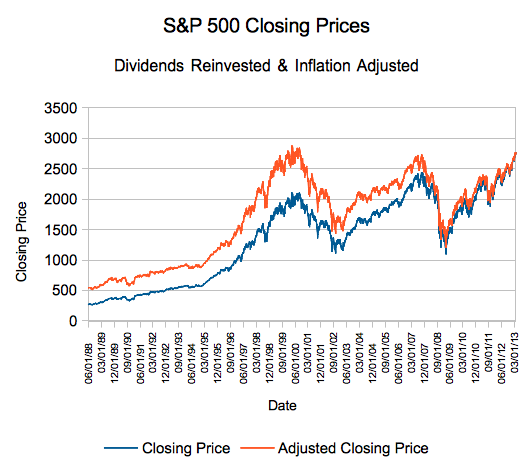Editor: On May 8, 2013 there was a new dividend adjusted closing high in the S&P 500.
Retained for posterity: On March 28, 2013 the S&P 500 Nominal Closing price 'broke' the record, so I updated the article. Sorry, folks - based on my daily CPI adjusted total return data, we're still 3.9% off the peak. I have updated the picture below. If someone pays me I'll make a daily S&P 500 calculator with CPI interpolation (not quitting my day job! Use monthly for now), otherwise just ask me to update this article every few months.
Last week we regaled you with tales about how we look down upon most financial reporting - we explained what we regard as the true closing high for the Dow Jones Industrial Average. We mentioned there that the S&P 500 was also approaching a high - left unanswered is whether we're at closing highs for the S&P 500.
Well, by our math - dividends reinvested, CPI adjusted... we aren't yet at a closing high for the S&P 500. And when was the actual high? 2006 or 2007, right?
Nope. March 24, 2000... right around 13 years ago.
Approaching an All Time High
That's right, we estimate that if you invested in the S&P 500 on 3/24/00 and reinvested all your dividends, you would have lost money through Friday's close (yet you might owe taxes on the dividends and capital gains). Here's the inflation adjusted chart:
Methodology
If you followed our corresponding story on the DJIA, you'll note that our methodology is much the same. The S&P 500 Total Return Index reflects what you would make in the S&P 500 if you reinvested all the dividends you received back into the S&P 500. It's like an ideal, no taxes mutual fund. To that, I add daily CPI prices (linear interpolation before February 2013, extrapolation after) to adjust closing prices for CPI-U.
Details on the S&P 500 total return index can be found with S&P. (We built a calculator using monthly data. Note the peak won't show up since monthly data is smoothed - put April 2000 until March 2013.).
Remember, the reason we like this methodology is because price returns don't reflect true investor performance (and yes, real investors do have to pay taxes and fees). Even if you don't reinvest dividends, you're still discounting a large number of payments over the ensuing years - our calculator estimates you would have lost about 21% in that time-span if you only looked at price return and inflation.
The S&P 500 - Still 4.2% Off Its High
Stated another way, we've still got 4.5% to go to hit our peak - and we're fighting against the tide of inflation.
Still, even though we were willing to inject a bit of merriment into our Dow Jones article, this is something a bit worse - it's a bit sad to see there have been negative real returns for 13 years.
So, save the champagne - (hopefully) soon we'll top the end of the Clinton days!

